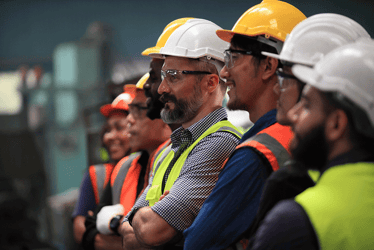The Packaging Industry's Sustainability Challenge: Why ERP Systems Are Essential for Success A straightforward guide to navigating sustainability regulations across folding carton, flexible...
Extended Producer Responsibility (EPR) in the packaging industry
The packaging industry, particularly the flexible packaging segment, has seen rapid growth due to its many advantages.
It is light-weight, convenient and provides unparalleled protection for the product it holds (especially food).
While it reduces carbon emissions compared to traditional rigid packaging it is challenging to recycle to its multilayer construction and plastic predominant content. As a result many governments have made the producers of these materials “responsible” for disposing of it through the Extended Producer Responsibility (EPR).
Contents
- The role of EPR in addressing recycling challenges
- Benefits of EPR for flexible packaging
- How EPR works for packaging
- The circular economy
The role of EPR in addressing recycling challenges
Extended Producer Responsibility (EPR) is a policy approach that shifts the responsibility for managing the end-of-life of packaging materials to the producers. Already widely adopted in electronics and other consumer products, EPR legislation requires companies that manufacture and sell the product also fund or manage the collection, recycling, and disposal of their products. Now, the packaging supply chain will need to adopt similar EPR management practices to their products.

Source: fdf.org.uk
Used well, EPR can incentivize recycling and use of bio-degradable materials by through several key mechanisms:
- Investment: Vital funding is directed into communities and the recycling value chain.
- Cost redistribution: Major expenses are transferred from municipalities to packaging producers.
- Access: Communities receive improved access to recycling services.
- Participation: Engagement in recycling programs rises.
- Education: Teaching and guiding consumers and retailers how to better dispose of plastic packaging for easier recycling.
In 2024, 10 U.S. states have implemented EPR legislation, and five new EPR bills for packaging have been passed, demonstrating growing support for this approach. These programs are increasingly viewed as essential for addressing the challenges of packaging waste, especially with single-use plastics and other hard-to-recycle materials.
Smart, well-designed EPR programs in U.S. states have the potential to revolutionize recycling by providing the financial investment necessary to modernize and expand recycling infrastructure. These programs can ensure 100% access to recycling for households, driving participation rates and significantly increasing the overall volume of materials recycled. In some states, recycling rates could rise as much as three times their current levels under EPR frameworks. Beyond boosting recycling rates, the benefits of such programs include retaining the economic value of recycled materials within the economy, reducing climate-damaging emissions, and creating jobs to manage the increased flow of recyclable materials. This combination of environmental and economic benefits makes EPR a key strategy for sustainable waste management.
Benefits of EPR for flexible packaging
Flexible packaging has grown into a $42.9 billion industry in the U.S., making it the second-largest packaging segment. Its versatility, lower emissions, and lightweight design have made it popular across sectors like food, healthcare, and consumer goods. However, despite its benefits, flexible packaging is notoriously difficult to recycle due to its multi-material layers, which often aren’t compatible with traditional recycling processes.
EPR policies offer multiple benefits for the flexible packaging industry. First, they incentivize innovation by pushing companies to design packaging that is easier to recycle. This often leads to the development of new materials and technologies that reduce the environmental impact of packaging. Additionally, EPR funds can be used to invest in much-needed infrastructure, helping to modernize recycling systems and make them more accessible for consumers.
For instance, improvements in sortation and processing technologies could enable the recycling of more complex materials like multi-layer flexible packaging. By redistributing the costs of waste management from taxpayers to producers, EPR creates a sustainable funding model that supports the entire recycling ecosystem.
How EPR works for packaging
EPR programs for packaging typically require producers to either manage their packaging waste individually or join a Producer Responsibility Organization (PRO). The PRO - usually a non-profit, collects fees from producers and uses these funds to finance the end-of-life management of covered packaging products, including collection, sorting, and processing. In some cases, EPR programs also cover consumer education, infrastructure improvements, and the development of new markets for recycled materials.
The financial structure varies, but in most cases, producers pay fees to the PRO, which then allocates the funds according to the program's legislative requirements. Some states refer to these PROs as stewardship organizations, and they manage the development and implementation of producer responsibility plans.
The circular economy
EPR is essential in driving the packaging industry towards a circular economy, where materials are continuously reused and recycled, minimizing waste. In regions with well-established EPR policies, such as parts of Europe, recycling rates have risen, and packaging waste has significantly decreased. This shift can be seen in the U.S., where the push for EPR legislation is gaining momentum.
Higher recycling rates in the packaging industry, achieved through EPR, would lead to several additional positive outcomes:
- Job creation: Expanding employment opportunities in material collection, processing, and end-use.
- Emission reduction: Lowering emissions that contribute to climate change.
- Equitable access: Providing fair access to recycling services for all residents.
- Economic benefits: Reintegrating valuable materials into state economies through EPR initiatives.
- Investment incentives: Stimulating investment in material processing and recycled product manufacturing.
- Budget relief: Alleviating costs for municipal budgets and reducing residential subscription fees.
As more states adopt EPR frameworks, the flexible packaging industry has a unique opportunity to lead in sustainability. Extended Producer Responsibility (EPR) encourages practices that benefit both the economy and the environment as it holds producers accountable for the entire life cycle of their products.
Ready to enhance your flexible packaging sustainability and meet EPR requirements? Discover how ePS Packaging solutions can streamline compliance and drive profitability with our range of packaging management software solutions.




